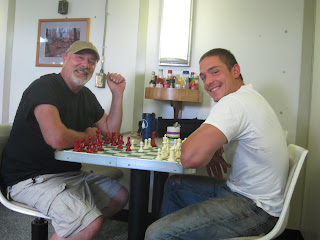
New Religion

by Bill Holm
This morning no sound but the loud
breathing of the sea. Suppose that
under all that salt water lived the god
that humans have spent ten thousand
years trawling the heavens for.
We caught the wrong metaphor.
Real space is wet and underneath,
the church of shark and whale and cod.
The noise of those vast lungs
exhaling: the plain chanting of monkfish choirs.
Heaven's not up but down, and hell
is to evaporate in air. Salvation,
to drown and breathe
forever with the sea.
"New Religion" by Bill Holm, from The Chain Letter of the Soul: New & Selected
Poems. © Milkweed Editions, 2009.
* * * *

Well, we are actually returning a day early.
So, if you want to meet me, just be at the Woods Hole Dock at 1630 hours (that’s 4:30 p.m.)
I will be available to sign autographs. Just kidding.
Still, I’m so glad Chief Scientist, Dr. Lloyd Keigwin gave us enough notice about the early return! I was able to prepare myself for the paparazzi

by giving myself a nice mud mask—using 250,000 old mud gathered from underneath the deep water in the Gulf of Maine.
What a luxury!
And, actually I do feel this has been a very glamorous and luxurious trip. Yes, it’s true being a ship for ten days can make for a rough and tumble environment--with all that mud and heavy equipment--but there have certainly been moments of grace and real beauty aboard the Knorr.

I met so many incredible people. And every single person I met taught me something new. For instance, this fellow, Wayne Hinkel—he’s an “ordinary seaman,” but there’s nothing ordinary about him.
Before he decided to spend his life at sea, he had planned to go to FIT in New York City to study fashion design. Yes, I actually found a fashionista on board! Oh, and he paints and he plays guitar. Yes, he’s an artiste and he certainly reminded me of that age old lesson to never judge a book by its cover!
That’s him playing chess with Joe. How intellectual. How civilized.
And speaking of civilized, I cannot leave you without telling you about the food and our magnificent chef, Bobbie Bixler.
Bobbie makes the most delectable creations. She is a culinary artist, completely devoted to her
 job of feeding this hard-working group scientists and crew. She began by studying cooking in Italy and has now been all over the world.
job of feeding this hard-working group scientists and crew. She began by studying cooking in Italy and has now been all over the world.Here's a photo of her seared tuna with garlic ginger drizzle.
That night’s menu also included:
Sesame seared tuna
Basmati rice
Butternut squash sauteed with a hint of curry

Sautéed French green beads
Braised red cabbage with sweet hot chipotle
The topper Bobbie’s black bean mango salsa
Flat iron steaks grilled the way you like them
Recipe for Bobbie’s Black Bean Mango Salsa for a Crowd
1 #10 can of black beans drained and quickly rinsed (6 lb. 10 oz)
4 large mangos peeled and diced a bit larger than the beans
1 medium red onion diced small
6 habanera peppers diced or minced 6-8 bunches of green onions finely sliced
2 cups cilantro diced
5-6 large juicy limes
Kosher or sea salt to taste, takes a bit

This salsa only needs about 3 hours to grab the flavor. To do it smaller, just use two 28 oz. cans or 2 lbs dry black beans and cut everything in half.
Safety First.
Time has a funny way of expanding and contracting when you’re at sea, and here it is my last day and suddenly the crew is talking to me. A lot! It actually began happening a few days ago. Little by little I got to know just about everyone. First the Captain (maybe that’s how it started—he gave me the seal of approval!) but then came Dee and Mike and Lee who invited me to tour the Engineer’s Room. I even finally talked to Pete, the man I was most afraid of because he does seem awfully busy and perhaps a little gruff.
I’ve come to realize that it takes time for these guys to befriend you, to trust you, but when they do-- it’s the most wonderful feeling in the world—because you can see that are completely sincere. Trust is a big deal on board of ship, because you never know and you want to make sure the person you’re with is going to be there for you, steady, calm, kind and reliable.
Because when you think about it, isn’t this a metaphor for life and for all relationships. Who do you trust? Who would you want to be in a lifeboat with?

So perhaps I would not be such a bad companion in a lifeboat. Perhaps the crew senses that I would not be the kind of gal who would forget to wear long sleeves and that I would not forget my hat.
And this brings me back to Dr. William G. Thompson.
My WHOI-Climate-Change Scientist-Man. After being on the sea for nine days, more than ever--I am glad I married him. I am glad I agreed to share a “lifeboat” with him.

And, I am so happy to know I will be seeing him in a matter of hours!
So, I must bid you adieu now, Sailors, Scientists and Sea!
xoxo
Jamie























